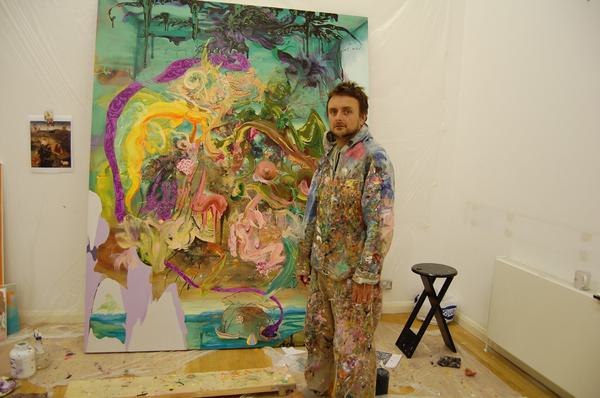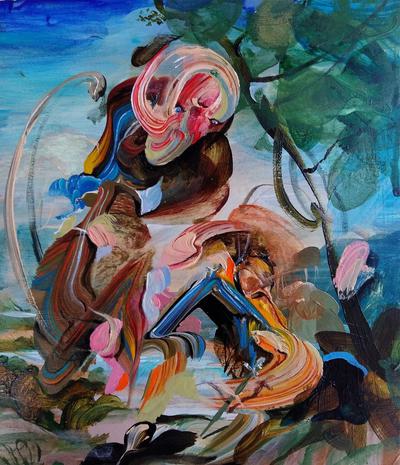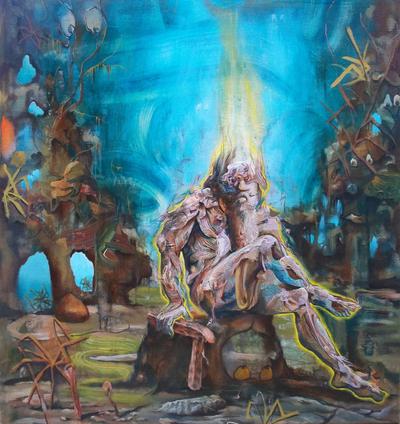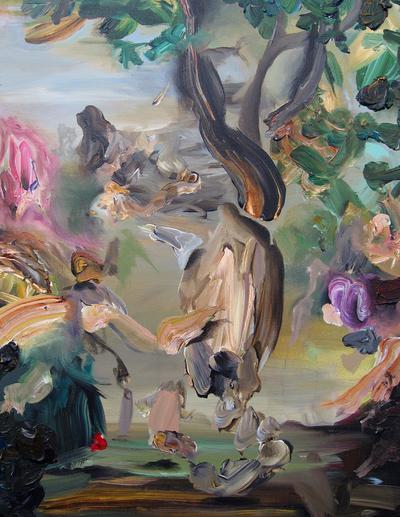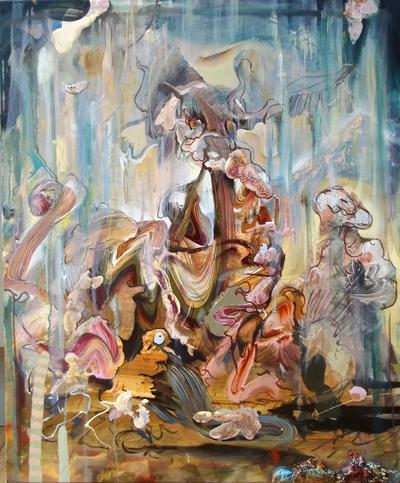Solo and two person exhibitions
2024 - Divine Comedies (with Carolein Smit) - James Freeman Gallery, London
2023 - 'Diorama'(with David Hancock) - The Parsonage, Manchester
2022 - Teraphim (with Carlos Zapata) - James Freeman Gallery, London
2020 - New Paintings - Gallery 339, Cao Chang di, Beijing.
2018 - Iain Andrews - House of the Nobleman, London
2015 - Changeling - York College Gallery, York
2014 - Re:view - Iain Andrews, Castlefield Gallery, Manchester
2013 - Il teatro dei leviatano - Man and Eve, London ,
- The Language of Paint (with Richard Kenton Webb), Atkinson Gallery, Somerset
2012 - Mythopoeia, Warrington Museum and Art Gallery, Warrington
2011 - Manchester Contemporary, Man and Eve , Manchester
2009 - The Pilgrimage of Lost Children and Other Stories, Bankley Mill, Manchester,
- Theoria, Gallery 286, London
1999 - Passion, The Crossing, St Paul's, Walsall, West Midlands
Group exhibitions
2025 - ‘The Omnipotence of Dream’ - Salford Museum and Art Gallery, Salford, ‘Arte Bologna’ with Galleria Gaburro, Bologna, ‘Paradise Lost’ - The Underground Stream gallery, Devon
2024 - 'Humana' - Gallery Gaburro, Milan, ‘Dreams and Nightmares’ - Boomer Gallery, London, ‘Assembly’ - Rye Creative Centre, Sussex, ‘What you see is neither art nor food’ - Galleria Gaburro, Milan, ‘Influencers’ - Blindarte, Milan, ‘Imaginary Lines’ - Daniel Katz Gallery, London
2023 - 'Resurrection' - James Freeman Gallery, London, 'Jackson's Painting Prize' - Oxo Gallery, London, 'X -10 years of Contemporary British Painting', Newcastle Contemporary Art, Newcastle, 'Rising Artists - Jackson's Painting Prizewinners' - Affordable Art Fair and Bankside Gallery, London, 'Paint Fiction' - International gallery of Contemporary Art, Anchorage, Alaska, 'AIR Open' - AIR Gallery, Altrincham, 'Trinity Buoy Wharf Drawing Prize' - Trinity Buoy Wharf, London, 'Paint' - Brownston Gallery, Devon.
2022 - 'Carnivals of Clouds - Janet Rady Fine Art, London, Manchester Open - HOME, Manchester, 'Sunny Art Prize' - Sunny Arts Centre, London, 'Paradoxes' - Quay Arts Centre, Isle of Wight, 'A Generous Space II ' - Walsall Art Gallery, Walsall, 'A Modest Show - Fayre Share Fayre' - Whitworth Art Gallery, Manchester, 'Vitalistic Fantasies' - Elysium Gallery, Swansea, 'Paper After All ' - Royal Cambrian Academy, Conwy, Paper Gallery, Manchester and touring, 'Meet me by the river' - Purslane art, London, 'Paint Edgy' - The Ropewalk Gallery, Barton -upon- Humber, 'Swamp Legends' - Terrace Gallery, London
2021 - 'Trinity Buoy Wharf Drawing Prize' - Cooper Gallery, Dundee, 'Thing Worlds' - Art Spot, Kyoto, Japan, 'Emergence' - Rise art, London, 'Momento Mori' - AIR Gallery, Altrincham, 'ArtWorks Open' - Barbican Arts Group, London,
2020 - 'Waving in the Distance' - Terrace Gallery, London, 'Vitalistic Fantasies' - Elysium Gallery, Swansea, 'Beep Painting Biennial' - Elysium Gallery, Swansea, 'Yes/No' - Contemporary British Painting virtual exhibition, 'New work' - Saul Hay Gallery, Manchester, 'Trinity Buoy Wharf Drawing Prize 2020' - Trinity Buoy Wharf, London, Drawing Projects, Trowbridge and Cooper Gallery, Dundee, 'Vitalistic Fantasies' - Cello factory, London, Plausible Objects / Difficult Things - CBP virtual exhibition curated by Dr. Frances Woodley
2019 - 'Angels' - James Freeman Gallery, London, 'Personal Structures', Paper Pavillion, Palazzo Mora, Venice Biennale, Venice, 'CBP' , Norwich Cathedral, Norwich, 'New Paintings', Saul Hay Gallery, Manchester, 'GMCC Art Prize' - Bolton Museum and Art Gallery, 'Made in Britain - British painting in the 21st century', National Gallery and Museum of Poland, Gdansk, 'Trinity Buoy Wharf Drawing Prize' -Drawing Projects, Wiltshire
2018 'Fresh paint', Messums Gallery, Wiltshire, 'Material Earth - Myth, material and Metamorphosis ', Messums Gallery, Wiltshire, 'Chaiya Art Award' - Oxo Gallery, London, 'New Light art prize exhbition', Huddersfield Art Gallery and touring to Bankside Gallery, London, ‘GMCC Art Prizewinners exhibition’, Stockport Art Gallery, Manchester, 'Tracing Paper'- Paper Gallery, Manchester, 'Trinity Buoy Wharf Drawing Prize' - London and touring throughout the U.K, 'TaoHuaTan International artists'- Hefei Museum of Modern Art, Anhui, China, 'New Paintings' St.Maryelbone Crypt, London
2017 ‘Testcard P’, St Marylebone Crypt, London, ‘Bankley Open’ , Bankley Gallery, Manchester, ‘Mardi gras Requiem’, Project Space Plus, University of Lincoln, ‘Contemporary British Painting’, Yantai Art Museum, Yantai and touring to Artali Gallery, Nanjing and Jiangsu Art Museum, Nanjing, ‘Strange Little Things’, Bankley Gallery, Manchester – ‘GMCC Art Prizewinners exhibition’, Chamber of Commerce, Manchester –‘Antennae’, Lubomirov Angus Hughes, London, 'New Light art prize exhibition', Bowes Museum, Durham
2016 ‘Correspond’, Artworks, Halifax and touring to London, Liverpool, Rye and Winchester, 'Sixty' - Lubomirov Angus- Hughes, London, 'Anthology' - Van der Plas Gallery, New York, New Work, Manchester Contemporary, Telling Tales, Collyer Bristow Gallery, London, Miniature World, Castlefield Gallery, Manchester, 30x30x43, St Marylebone Crypt, London
2015 - How the Light gets in, The Globe, Hay on Wye, - Bankley Open, Bankley Gallery, Manchester, - National Open Art Competition, Royal College of Art, London
2014 - (DETAIL) H Project Space, Bangkok (June) and Transition Gallery, London (September) Curator Andrew Bracey, - Open up North, Brewery Arts Centre, Kendal, - Bankely Open, Bankley Gallery, Manchester
2013 - Beautiful Things, next door projects, Tate Liverpool, - The Tip of the Iceberg, Contemporary Art Society, London
2012 - 60 Drawings, Bankley Gallery, Manchester , - A Private Affair, Harris Museum and Art Gallery, Preston , - Collectible, Zeitgeist Arts Projects, London, - Digital Romantics, Dean Clough Gallery, Halifax, - International Beethoven Project, National Pastime Theatre, Chicago, - Manchester Contemporary , (with man & eve), Manchester, - Polemically Small, Orleans House Gallery, Twickenham, - Pulse (with Man and Eve), New York, NY, - Put your money where your eyes are, Fundraising Auction for Castlefield Gallery, Castlefield Gallery, Manchester, - The Wreck of the Imagination, Sarah O'Kane Fine Art, Lewes
2011 - Art Works Open, Barbican Arts Group, London, - Configured, Signal Gallery, London, - Contemporary Approaches to Watercolour, Mall Galleries, London, - Deptford X, Core Gallery, London, - Desire, Portman Gallery, Soho, London, - Jerwood Drawing Prize, Jerwood Space, London, - National Open Art Competition, Pallant House, Chichester, - Polemically Small (curated by Edward Lucie Smith), Garboushian Gallery, Los Angeles, - The Open West, Gloucester Art Gallery, Gloucester, - The Return - House of the Nobleman, Boswall House, Regents Park, London, - We are all in this together, Bureau Gallery, Manchester
2010 - Marmite Painting Prize, Thameside Art gallery, Lanchester Gallery, Coventry, The Nunnery, London, Touring Exhibition, - The Borrowed Loop, Man and Eve Gallery, London, - The Summer Show, Sarah O'Kane Fine Art, East Sussex
2009 - New Paintings (with Genieve Figgis), Queen Street Studios, Belfast
2008 - Budapest Art Fair, Budapest, Hungary, - Edge of Figuration, Tregoning Fine Art, Derby, - Horse Power, Metal, Edge Hill Station, Liverpool, - Imaging the Bible, Aberystwyth Arts Centre, Aberystwyth, - New Blood Art Fair, Lighthouse, London, - Night Thoughts, Royal West of England Academy, Bath, - Top 100, MCPS/PRS Alliance Building, London
2007 - Annual Exhibition, The Mall Gallery, London, - Battersea Contemporary Arts Fair, BAC, London, - From Bacchus to Barbie, Signal Gallery, London, - New Work, Tregoning Fine Art, Derby, - Sefton open, Atkinson Art Gallery, Southport
2006 - Derby Open, Derby City Art Gallery, Derby
2005 - Art of Imagination, Galerie Venere, Italy, - Art of Imagination Touring European exhibition, Lofthouse Galerie / Silos Gallery, Germany / Spain
2004 - Challenge the Nail, Salon Des Arts, London
2003 - Art and Vision, Williamsburg Art Centre, New York, - Art of the Imagination, Gallery 37, London and Kircudbright, Scotland, - Religion, Art and War, Salon Des Arts, London, Yugoslavia and Israel
2002 - Art of the Imagination, Gallery 37, Cork Street, London, - Eyepoppers, Gloucester City Art Gallery, Gloucester, - Goldmark Gallery, Uppingham, Rutland
1998 - Images of landscape, Heifer Gallery, London
Private commissions
2005 - Portrait of M.A.Evans, retiring head of Trinity Church of England School, Trinity Church of England School, Manchester
Competitions, prizes and awards
2023 - Jackson's Painting Prize, Mind's Eye Winner
2020 - Trinity Buoy Wharf Drawing Prize, shortlist,
2019 - GMCC Contemporary Arts Prize - runner up
2018 - Trinity Buoy Wharf Drawing Prize, shortlist, Chaiya Art award - shortlist
2017 - GMCC Contemporary Arts Prize - runner up, New Light Art Prize, shortlist
2016 - GMCC Contemporary Arts Prize - runner up
1st Prize - Anthology, Van der Plas Gallery, NY
2014 - Open up North - 1st Prize
2012 - The Northern Art Prize 2013, longlist, Leeds
2011 - Marmite Painting Prize - 1st Prize, Nunnery, Bow Arts, London,
Towry Prize - North of England, National Open Art Competition, Chichester,
Jerwood drawing prize, London
2010 - Jerwood Painting Fellowship, shortlist, Jerwood space, London
2009 - Abbey Scholarship in Painting, Shortlisted, British School of Rome, Rome,
Saatchi's Best of British, shortlist, Saatchi Gallery, London
2008 - Marmite Art Prize, Studio 1.1, London
2007 - Celeste Art Prize 2007 - Short List, London,
Sir Leslie Joesph Young Artist Award - Shortlist, Glynn Vivian Art Gallery, Swansea
2002 - LUKAS Drawing Prize, Gallery 37, Cork Street, London
Publications / Selected Press
2014 - Pick of the weeks Exhibitions - Guardian Guide http://www.theguardian.com/artanddesign/2014/mar/15/this-weeks-new-exhibitions
2012 - Mythopoeia - exhibition catalogue with essays by Graham Crowley and Edward Lucie Smith
2011 - front cover, a-n magazine, - Jerwood Drawing Prize 2011 Catalogue, - Marmite Painting Prize, exhibition catalogue, One to watch, a kick up the arts website, Editors Pick, Top ten International shows, Saatchi Online magazine, One to watch, FAD, www.fadwebsite.com
2010 - review of 'The Borrowed Loop' a-n, October
2009 - School of Saatchi, BBC2, The Vacuum, Issue 41
2006 - What the World Needs Now, BBC 1,
2003 - Religion Art and War exhibition catalogue, Imperial College, London
Collections
The New Art Gallery, Walsall
The Progressive Collection, Ohio
Warrington Art Gallery
Yantai Art Museum, Yantai, China
Private collections in the U.K, Denmark, U.S.A, Hong Kong, Brazil
Other
2024 - Xenia Creative Residency, Basingstoke
2019 - Residency, Gallery 339, Beijing
2016 - The Utility of colour - lecture given at Cambridge University
2015 - Artist's talk - in conversation with Richard Davey at Usher gallery, Lincoln
2013 - Artist's talk - in conversation with Richard Kenton Webb at Atkinson gallery,
2013 - Neo Art Prize - selection panel
2012 - The Marmite Painting Prize - selection panel
2011 - The Open West - selection panel
2011 - Jacob's Island residency, London
2010 - Who cares if it's art or not, is it any good? - lecture given at Liverpool Cathedral, - The Good the True and The Beautiful - Lecture given at the University of Wales
